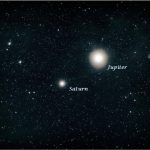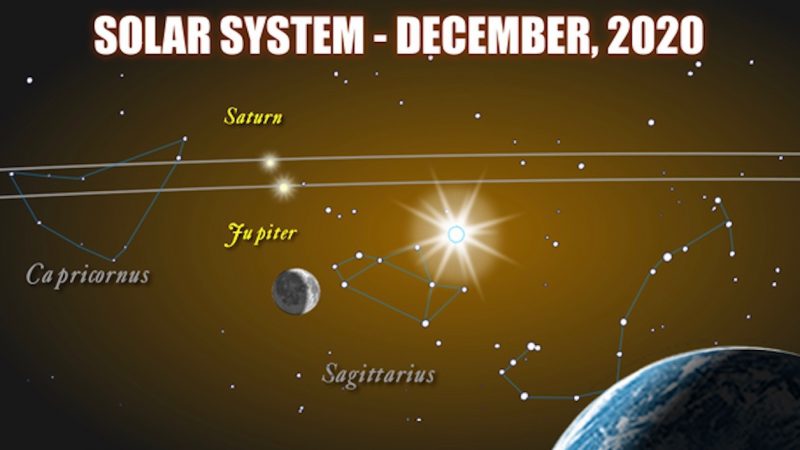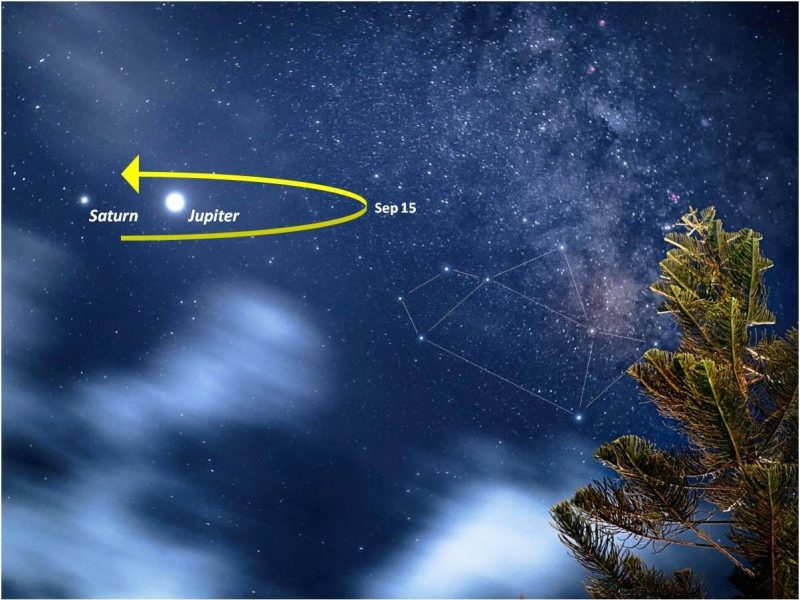

View at EarthSky Community Photos. | Closeup of Jupiter and Saturn, via Dr Ski. Saturn is now closely following Jupiter westward across the sky each night. Watch for the pair in June from mid-to-late evening until dawn. Although Saturn is easily as bright as a 1st-magnitude star, the ringed planet pales next the the king planet Jupiter, which outshines Saturn by some 15 times. Thank you, Dr Ski!
Astronomers use the word conjunction to describe meetings of planets and other objects on our sky’s dome. They use the term great conjunction to describe a meeting of two particular planets, very bright Jupiter and golden Saturn. The last great Jupiter-Saturn conjunction was May 28, 2000. The next one will be December 21, 2020. But don’t wait until December to start watching these worlds. They’re visible tonight and every night – near each other for the rest of 2020 – an appealing and mind-expanding sight!
At the 2000 great conjunction, Jupiter and Saturn were near the sun in our sky and difficult to observe. We’re due for a more observable great conjunction, and we’ll get one. By December, Jupiter and Saturn will be visible in the west shortly after sunset.
That’s not where Jupiter and Saturn are now, however. In 2020, the pair appeared in the east before sunup in February. As the weeks passed, we watched them shift higher up in the predawn sky, where they were joined by Mars:

View at EarthSky Community Photos. | Jupiter, Saturn, Mars and the moon on May 17, 2020. In May, these planets have been stretched across the sky in a graceful line shortly before sunup. They follow a line across our sky because the planets of our solar system orbit the sun in a nearly flat plane. That plane (as defined by the Earth-sun plane) is called the ecliptic. Thus, whenever you’re looking for planets, be sure to look along the path traveled by the sun from east to west each day.
Now – as Earth has pursued its smaller, faster orbit around the sun – Jupiter and Saturn have come into view earlier at night. As June approaches, they’re rising so early that you can glimpse them ascending over your eastern horizon by about midnight. You’ll recognize them easily. Jupiter is brighter than any star. Saturn is not as bright as Jupiter, but it’s as bright as the brightest stars and shines with a distinctly golden color.
Unlike the twinkling stars, Jupiter and Saturn both shine steadily. Your next opportunity to identify them near the moon will be around June 7 and 8.

The moon, Jupiter and Saturn rising together in mid-to-late evening on June 7 and 8, 2020. As viewed from the Northern Hemisphere, they’ll rise into your southeastern sky. Read more. For a specific view from your particular location, try Stellarium-Web.
Saturn, the sixth planet outward from the sun, is the farthest and slowest-moving planet that we can easily see with the eye alone. Dazzling Jupiter, the fifth planet outward from the sun, is the second-slowest bright planet, after Saturn.
For that reason, Jupiter/Saturn conjunctions are the rarest of bright-planet conjunctions, by virtue of their slow motions in front of the constellations of the zodiac. Saturn takes nearly 30 years to go around the sun full circle whereas Jupiter takes nearly 12 years.
Thus, every 20 years, Jupiter catches up to Saturn as viewed from Earth.

Artist’s concept of Jupiter and Saturn in December of 2020, as viewed from a space-based perspective. Their conjunction will be December 21. See the moon in this drawing? It’ll be along our line of sight to the planets on December 16, 2020. Chart via Jay Ryan at ClassicalAstronomy.com.
From the years 2000 to 2100 inclusive, as viewed from our planet Earth, these Jupiter/Saturn conjunctions (in ecliptic longitude) happen on these dates:
May 28, 2000
December 21, 2020
October 31, 2040
April 7, 2060
March 15, 2080
September 18, 2100
These great Jupiter/Saturn conjunctions recur in periods of 20 years. Each year, Saturn completes about 12 degrees of its orbit around the sun, whereas Jupiter completes about 30 degrees. Therefore, in one year, Jupiter closes the gap between itself and Saturn by about 18 degrees (30 – 12 = 18 degrees). In a period of 20 years, then, Jupiter gains 360 degrees on Saturn (18 x 20 = 360 degrees), therefore lapping the ringed planet once every 20 years.
So start watching Jupiter and Saturn now! They’ll be at their best during June, July and August. During these months, Earth will pass between both Jupiter and Saturn and the sun, bringing these planets opposite the sun in our sky, to a position called opposition by astronomers. Jupiter will come to opposition on July 14. Saturn’s opposition will be July 20.
At opposition – when we on Earth are seeing these worlds opposite the sun – Jupiter and Saturn will rise in the east at sunset, appear highest in the sky at midnight, and set at sunrise. Afterwards, they’ll rise earlier and set earlier, day by day, appearing for fewer and fewer nighttime minutes throughout September, October, November and December.
The great conjunction of Jupiter and Saturn on December 21, 2020, will mark the end of the year of observing these worlds … and what a great year it is! Don’t miss Jupiter and Saturn in 2020.

View at EarthSky Community Photos. | Dr Ski added an arrow to show that Jupiter and Saturn are now moving in retrograde (westward) toward the famous Teapot pattern in the constellation Sagittarius. They won’t quite make it before resuming their normal, eastward motion in mid-September 2020. Thanks, Dr. Ski.
Bottom line: The upcoming great conjunction of Jupiter and Saturn will be December 21, 2020. This is a once-in-20-years event. The planets are visible now and will be at their best in June, July and August. Watch for them.
from EarthSky https://ift.tt/2WVmFCm


View at EarthSky Community Photos. | Closeup of Jupiter and Saturn, via Dr Ski. Saturn is now closely following Jupiter westward across the sky each night. Watch for the pair in June from mid-to-late evening until dawn. Although Saturn is easily as bright as a 1st-magnitude star, the ringed planet pales next the the king planet Jupiter, which outshines Saturn by some 15 times. Thank you, Dr Ski!
Astronomers use the word conjunction to describe meetings of planets and other objects on our sky’s dome. They use the term great conjunction to describe a meeting of two particular planets, very bright Jupiter and golden Saturn. The last great Jupiter-Saturn conjunction was May 28, 2000. The next one will be December 21, 2020. But don’t wait until December to start watching these worlds. They’re visible tonight and every night – near each other for the rest of 2020 – an appealing and mind-expanding sight!
At the 2000 great conjunction, Jupiter and Saturn were near the sun in our sky and difficult to observe. We’re due for a more observable great conjunction, and we’ll get one. By December, Jupiter and Saturn will be visible in the west shortly after sunset.
That’s not where Jupiter and Saturn are now, however. In 2020, the pair appeared in the east before sunup in February. As the weeks passed, we watched them shift higher up in the predawn sky, where they were joined by Mars:

View at EarthSky Community Photos. | Jupiter, Saturn, Mars and the moon on May 17, 2020. In May, these planets have been stretched across the sky in a graceful line shortly before sunup. They follow a line across our sky because the planets of our solar system orbit the sun in a nearly flat plane. That plane (as defined by the Earth-sun plane) is called the ecliptic. Thus, whenever you’re looking for planets, be sure to look along the path traveled by the sun from east to west each day.
Now – as Earth has pursued its smaller, faster orbit around the sun – Jupiter and Saturn have come into view earlier at night. As June approaches, they’re rising so early that you can glimpse them ascending over your eastern horizon by about midnight. You’ll recognize them easily. Jupiter is brighter than any star. Saturn is not as bright as Jupiter, but it’s as bright as the brightest stars and shines with a distinctly golden color.
Unlike the twinkling stars, Jupiter and Saturn both shine steadily. Your next opportunity to identify them near the moon will be around June 7 and 8.

The moon, Jupiter and Saturn rising together in mid-to-late evening on June 7 and 8, 2020. As viewed from the Northern Hemisphere, they’ll rise into your southeastern sky. Read more. For a specific view from your particular location, try Stellarium-Web.
Saturn, the sixth planet outward from the sun, is the farthest and slowest-moving planet that we can easily see with the eye alone. Dazzling Jupiter, the fifth planet outward from the sun, is the second-slowest bright planet, after Saturn.
For that reason, Jupiter/Saturn conjunctions are the rarest of bright-planet conjunctions, by virtue of their slow motions in front of the constellations of the zodiac. Saturn takes nearly 30 years to go around the sun full circle whereas Jupiter takes nearly 12 years.
Thus, every 20 years, Jupiter catches up to Saturn as viewed from Earth.

Artist’s concept of Jupiter and Saturn in December of 2020, as viewed from a space-based perspective. Their conjunction will be December 21. See the moon in this drawing? It’ll be along our line of sight to the planets on December 16, 2020. Chart via Jay Ryan at ClassicalAstronomy.com.
From the years 2000 to 2100 inclusive, as viewed from our planet Earth, these Jupiter/Saturn conjunctions (in ecliptic longitude) happen on these dates:
May 28, 2000
December 21, 2020
October 31, 2040
April 7, 2060
March 15, 2080
September 18, 2100
These great Jupiter/Saturn conjunctions recur in periods of 20 years. Each year, Saturn completes about 12 degrees of its orbit around the sun, whereas Jupiter completes about 30 degrees. Therefore, in one year, Jupiter closes the gap between itself and Saturn by about 18 degrees (30 – 12 = 18 degrees). In a period of 20 years, then, Jupiter gains 360 degrees on Saturn (18 x 20 = 360 degrees), therefore lapping the ringed planet once every 20 years.
So start watching Jupiter and Saturn now! They’ll be at their best during June, July and August. During these months, Earth will pass between both Jupiter and Saturn and the sun, bringing these planets opposite the sun in our sky, to a position called opposition by astronomers. Jupiter will come to opposition on July 14. Saturn’s opposition will be July 20.
At opposition – when we on Earth are seeing these worlds opposite the sun – Jupiter and Saturn will rise in the east at sunset, appear highest in the sky at midnight, and set at sunrise. Afterwards, they’ll rise earlier and set earlier, day by day, appearing for fewer and fewer nighttime minutes throughout September, October, November and December.
The great conjunction of Jupiter and Saturn on December 21, 2020, will mark the end of the year of observing these worlds … and what a great year it is! Don’t miss Jupiter and Saturn in 2020.

View at EarthSky Community Photos. | Dr Ski added an arrow to show that Jupiter and Saturn are now moving in retrograde (westward) toward the famous Teapot pattern in the constellation Sagittarius. They won’t quite make it before resuming their normal, eastward motion in mid-September 2020. Thanks, Dr. Ski.
Bottom line: The upcoming great conjunction of Jupiter and Saturn will be December 21, 2020. This is a once-in-20-years event. The planets are visible now and will be at their best in June, July and August. Watch for them.
from EarthSky https://ift.tt/2WVmFCm

Aucun commentaire:
Enregistrer un commentaire